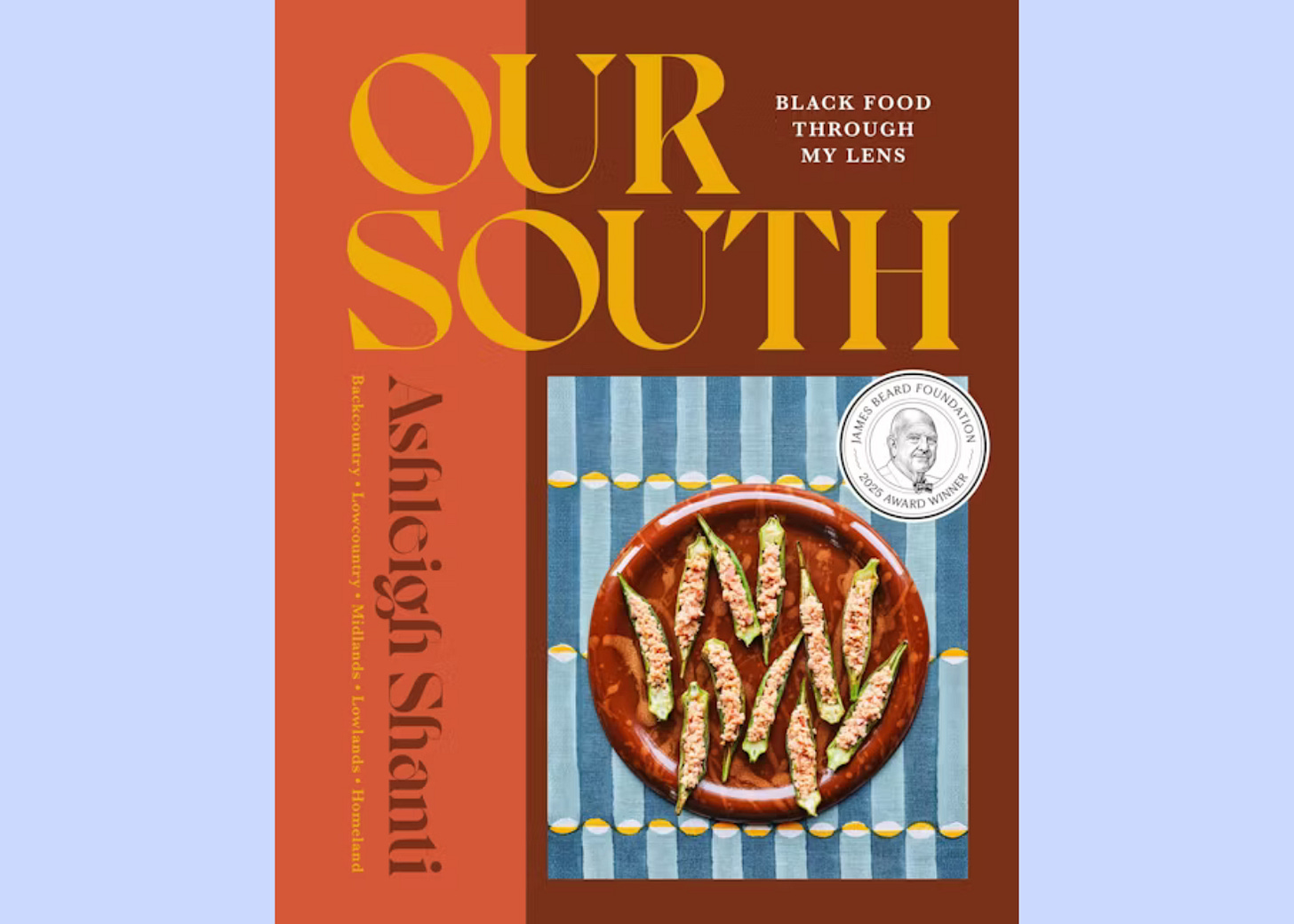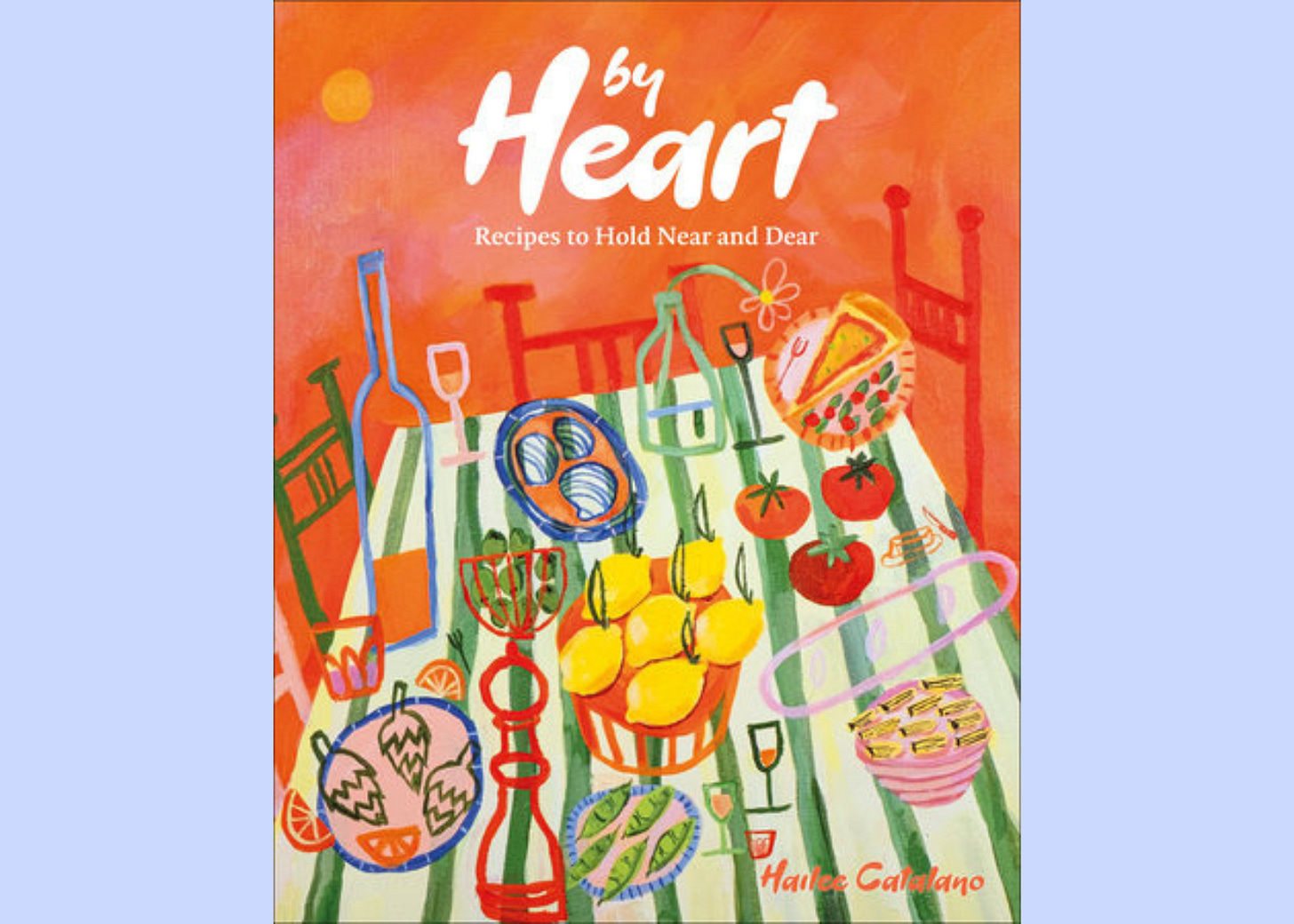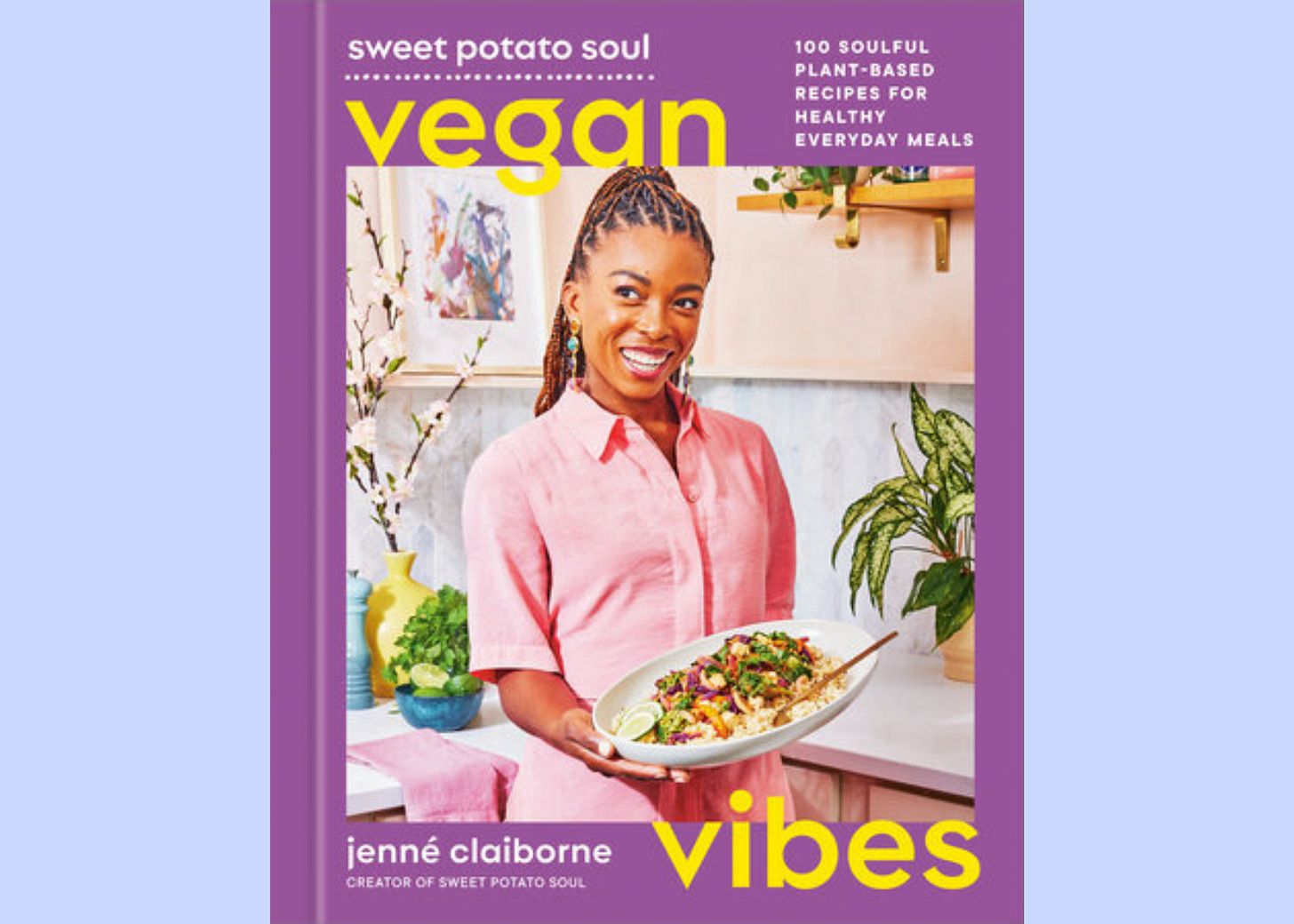I’m continuing to work my way through the backlog of books on my coffee table, so a greater proportion here than I’d like are books that are no longer hot off the presses…but still worth a look. Have a book you’d like to see covered quickly here or in a full review? Tell me!
*Our South: Black Food Through My Lens, by Ashleigh Shanti
Recent winner of a James Beard award, Asheville chef and Good Hot Fish owner Ashleigh Shanti has written a lyrical, deeply personal book that takes readers through her mix of family history, personal experience, and the Black culture of the Southern and Appalachian regions that she wants to highlight: backcountry, lowcountry, midlands, lowlands, and finally, “homeland.” Filled with vibrant photos, Our South includes basics such as cornbread and stewed tomatoes and old (or old-inspired) recipes such as fermented sour corn or salt-rising bread with butter flavored with country ham and ramps. (Sour is a recurring theme in this book, as in vinegar-cured trout with pickled Granny Smith apples.)
Though most recipes are eminently doable, Shanti doesn’t shy away from challenging ones, such as rosin-cooked potatoes with spruce tip butter. It’s hard to imagine many readers actually making that, as it requires a pine rosin cooker, 5 pounds of rosin, and fresh spruce tips, along with cooking outside because the rosin is highly flammable, with toxic fumes. But, Shanti argues, this lesser-known foodway of Black culture, while a massive undertaking, deserves recognition and creates “the most pure, potato-y potato.”
The juxtaposition of that recipe with one, two pages later, for a bologna schnitzel sandwich with sour collards, and another a page later for spaetzle with squash—part of the melting pot of Appalachian cuisine—brings home the book’s “Black food through my lens” subtitle.
So many recipes will beckon readers. Here’s just a sampling, which doesn’t really do the book’s breadth justice:
A takeoff on vinegar pie, which she traces to Depression-era make-do foods—creates a cider vinegar version of lemon bars, drizzled with sorghum molasses. A lowcountry recipe for benne seed crab toast, served with yellow mustard mixed with sorghum molasses, miso, and gochujang, seems to incorporate new and old ingredients both robustly and delicately. Crab appears again as a filling for deviled eggs, drizzled with a roasted red pepper vinaigrette flavored with lime, sorghum molasses, cilantro, chives, and peanuts. A puff pastry croustade is filled with a simple mix of crawfish, cheddar, and Muenster.
Chunks of day-old cornbread go on a platter to soak up a pour of buttermilk and a thick fennel and blueberry vinaigrette. Country sausage and rice-stuffed eggplant gets served with a tomato and peanut gravy. And sweet potato consommé, flavored with cinnamon and cloves, allows Shanti to merge her culinary training with a standard Southern ingredient.
By Heart: Recipes to Hold Near and Dear, by Hailee Catalano
By Heart is not a book that seems to fit its title; these aren’t recipes you’ll come to know “by heart.” But they hold meaning for the author, and many may come to do so for readers, too. Hailee Catalano’s culinary school and restaurant training shine through in varied recipes that lack a through-line—except for being generally interesting and accessible.
She takes cooks through chapters on everything from pickles to salads to pizza to her grandmother’s Italian-American creations, and to sourdough and a few breads plus many flavored butters. While some recipes are simple enough to memorize (an eye-catching platter of watermelon radish and persimmon slices topped with ricotta salata), many are more involved or have longer ingredient lists, such as “mozzarella sticks” of zucchini blossoms, sunchoke clam chowder, and handmade goat cheese ravioli in a mushroom broth. But readers will appreciate the layered flavors.
A recipe for hot cherry pepper jam, for example, starts with a jar of sliced, pickled hot peppers, ups the ante with chopped Fresno peppers, and spices it further with fresh ginger. A tiny note below the recipe suggests topping ricotta with the jam, olive oil, and herbs for a focaccia dip, or using it to top pizza. (Many recipes have these tiny, easily overlooked notes—not the best design choice, since they often contain useful information better suited to a headnote, or at least a more prominent point size.)
She puts a peach vinaigrette seasoned with maple syrup and urfa biber on charred, twice-cooked sweet potato slices topped with mint leaves fried in brown butter.
One especially fun recipe, and the only one I tested, is her mortadella “nduja”—a paste of mortadella and prosciutto for cooks who lack access to true nduja. Rich and spicy with Calabrian chilies, the paste flavors a creamy pasta, topped with crunchy pistachios and scented with basil.
*Sweet Potato Soul Vegan Vibes: 100 Soulful Plant-Based Recipes for Healthy Everyday Meals, by Jenné Claiborne
The idea of actually being vegan holds little appeal for me; I would sorely miss cheese, eggs, and cream even if I left all fish and meat behind. But many recipes can feel “naturally” vegan, as this shows—a good option for cooks of all stripes.
A successful vegan, blogger Jenné Claiborne writes in all caps, is “HEALTHY, VIBRANT, AND COLORFUL.” But she notes that while vegan food is more accessible than ever, it’s also more processed than ever. Claiborne addresses how to eat healthfully, get plenty of protein and fiber, and limit processed or sugary foods while still enjoying what you eat.
So her recipes include chocolate pancakes, carrot and mango muffins, and banana pudding with a miso caramel alongside usual suspects like tofu, cauliflower, and mushrooms.
Of course, non-vegans won’t have all the required ingredients hanging around their pantries: Biscuits are made with spelt flour, while lentil-based breakfast sausages include vital wheat gluten, nutritional yeast, potato starch, and miso. But most of what Claiborne calls for are now standard in large supermarkets.
Even for non-vegans, the recipes will feel familiar, such as snack, salad, and soup recipes like roasted Brussels sprouts with cranberries; hummus; latkes made with beets and russet and sweet potatoes; broccoli salad; and chickpea tomato soup. Main dishes include jackfruit chili, curried red bean tacos, miso corn pasta, and pea pesto pasta. Even more unusual recipes don’t branch out too far, such as kale chips coated in a paste of sunflower seeds, dates, cocoa, and cayenne.
Zoë Bakes Cookies, by Zoë François
From a reliable author (who found fame with five-minute artisan bread recipes), Zoë Bakes Cookies hits a sweet spot of detail without overload. Newbie bakers, or bakers who want to see how varying technique or ingredients makes a difference, will find detailed explanations from Zoë François in her “cookie academy” section and notes on ingredients and equipment, but recipes are clear and concise for bakers who just want to get their ovens going.
François opens with her path to baking fame, which began improbably on a Vermont commune with little access to sweets and an effort to convince kids that carob was just as good as chocolate, moving on to a cute cookie cart during her college days, her bread bestsellers and beyond.
With chapters broken down by healthy cookies, holiday cookies, Jewish favorites, “wordly” cookies, chocolate chip and brownie variations, and midwestern cookies and bars, she winds through a lot of basics.
There won’t feel like a lot new here, and in many ways there isn’t—you can find recipes for rice crispy bars, rugelach, madeleines, Russian tea cakes, biscotti, alfajores, linzer cookies, and oatmeal cookies in countless other books, not to mention online.
But bakers can learn a tip or two in many recipes: For chocolate crinkle cookies, roll the dough balls not just in powdered sugar but granulated sugar as well; replace some all-purpose flour with spelt in cutout sugar cookies; add bitters to lemon bars. For a variation on flourless three-ingredient peanut butter cookies, use egg whites instead of whole eggs (these were, like all flourless peanut butter cookies, pleasantly crumbly-chewy, but I found they missed the bit of lift and lightness that baking soda often adds).
In some spots, the attention to detail falters a bit. For example, does she really mean fresh lavender buds for shortbread—and if so, why isn’t there an option to use dried? And while many doughs are rolled into logs for slicing, she gives no tips for success, surprising given that these are often harder to get picture-perfect than bakers expect.
Pro tip: Make her carrot cake whoopie pie cookies for the filling alone. I didn’t test it, but I didn’t need to—the combination of cream cheese, honey, and vanilla has been my go-to carrot cake frosting for decades, and while it’s trickier to work with minus the stiffening of gobs of powdered sugar, it’s light-years ahead in taste and texture.
*I haven’t tested any recipes in this book.
Disclosure: I am an affiliate of Bookshop.org, which supports independent booksellers, and I will earn a commission if you click through and make a purchase on any of the titles above.






